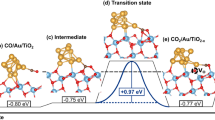Abstract
A novel contribution to the mechanism of heterogeneous catalysis is discussed for a model H2-on-nickel (100) system. The effect, which corresponds in a first approximation to the dispersion energy between adsorbate molecule and metal, is calculated through (1) admixture of an ionic component in the wave function of the adsorbate; (2) interaction between this ionic component and the image dipole which it creates in the polarizable metal. A single VB model, using an Anderson-type evaluation of the delocalization energy between adsorbate and metal, shows the image contribution to be 10 to 15% of the total adsorbate ↔ metal interaction energy.
Similar content being viewed by others
References
see,inter alia, J.E. Lennard-Jones, Trans. Far. Soc. 28 (1932) 233;
D.M. Newns, Phys. Rev. 178 (1969) 1123;
T.B. Grimley, J. Phys. 31, Suppl. C1 (1970) 85;
A.B. Anderson, J. Am. Chem. Soc. 99 (1977) 696;
N.D. Lang and A.R. Williams, Phys. Rev. B18 (1978) 616;
J.K. Norskov, A. Houmøller, P.K. Johansson and B.I. Lundqvist, Phys. Rev. Lett. 46 (1981) 257;
P.K. Johansson, Surf. Sc. 104 (1981) 510;
J.Y. Saillard and R. Hoffmann, J. Am. Chem. Soc. 106 (1984) 2006;
E. Shustorovich and R.C. Baetzold, Science 227 (1985) 876;
L. Salem, J. Phys. Chem. 89 (1985) 576;
C. Minot, B. Bigot and M. Hariti, Nouv. J. Chim. 10 (1986) 461;
R. Hoffmann, Revs. Mod. Phys. 60 (1988) 601.
J.R. Schrieffer and R. Gomer, Surf. Sc. 25 (1971) 315.
W. Kolos and L. Wolniewicz, J. Chem. Phys. 43 (1965) 2429.
W. Kolos and L. Wolniewicz, J. Chem Phys. 45 (1966) 509.
P.W. Anderson, Phys. Rev. 115 (1959) 1; Solid State Physics 14 (1963) 99.
M. Hliwa, J.C. Barthelat, M. Pélissier and F. Spiegelmann, Chem. Phys. Lett. 132 (1986) 205. We concentrate on those curves which dissociate into H 1s(2S) and Cu d10 s1 (2s) in order to mimic as closely as possible the behavior of Ni d9.4 s0.6.
K. Christmann, Surf. Sc. Reports 9 (1988) 1, in particular table 4.
N.W. Ashcroft and N.D. Mermin,Solid State Physics (Holt, Rinehart and Winston, Philadelphia, 1976) p. 38.
P. Jennings and R.O. Jones, Advances in Physics 37 (1988) 341.
M.M. Karelson, A.R. Katritzky, M. Szafran and M.C. Zerner, J. Org. Chem. 54 (1989) 6030;
T. Steinke, E. Hänsele and T. Clark, J. Am. Chem. Soc. 111 (1989) 9107.
A. Warshel, Biochemistry, 20 (1981) 3167;
A. Warshel and S. Russell, J. Am. Chem. Soc., 108 (1986) 6569.
E. Teunissen, F. van Duyneveld and R.A. van Santen, J. Phys. Chem., submitted for publication.
Author information
Authors and Affiliations
Rights and permissions
About this article
Cite this article
Malrieu, J.P., Salem, L. The instantaneous image effect: A novel contribution to the mechanism of heterogeneous catalysis. Catal Lett 9, 287–296 (1991). https://doi.org/10.1007/BF00773186
Issue Date:
DOI: https://doi.org/10.1007/BF00773186




